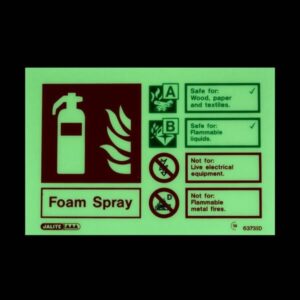Fire & Safety Signage – A focus on Escape Route Signage
It is now a requirement that all signage complies to satisfy The Regulatory Reform (Fire Safety) Order and The Health and Safety (Safety Signs & Signals) Regulations. So, simply put, you need to ensure the signage within your premises is correctly assigned and it’s to the latest requirements. The Standard for Signage of this type falls under BS EN ISO 7010:2012, basically a standard recognised in Britain, Europe and Worldwide
Types of signage as follows: –
- Fire Extinguisher Identification
- Fire Fighting Equipment
- Fire Safety Instructions
- Fire Action Notices
- Hazard Warning & Prohibition Signs
- Exit, Fire Exit, Assembly Point & Emergency Door Escape Mechanism Signs
There is also a requirement that these be visible in a premises in the event of power failure which means that they should be illuminated by an emergency light or more cost effectively that they be photoluminescent. These are signs that absorb photons and then emit them in darkness making the sign glow.
Fire escape signs are provided in buildings to guide you from wherever you are, via a place of relative safety, the escape route, to the designated place of ultimate safety, the assembly area.
Fire escape signs are not normally required on the main route into or out of a building i.e. the one used by people for normal arrival and exit, however alternative escape routes and complicated escape routes do need to be signed. It must not be assumed that everyone will know all safe routes through the building. Importance must be given to providing people with an easy visual indication of which way to go in the event of an emergency.
Similarly, it must not be assumed that, once outside the building via a final exit, people will know how to get to the assembly area, so signs directing to the assembly area will be needed as well.
Fire escape signs are green and white, this is deemed a safe condition. They must comprise a pictogram, an arrow, and possibly words. A sign with just an arrow, or just words, or an arrow and words is not sufficient. There must be a pictogram including the “rapidly walking man”. Signs to British Standard 5499: part 4:2000 have the man passing through a door. Another way to identify signs to BS5499 is that the text is in lower case apart from the first letter.
Signs that are illuminated from behind or within ,as in the case of an escape light with escape sign incorporated, will have a white figure entering a green door with a white surround.
You may encounter signs to European Standard 92/58/EEC. These are identified by all upper case text, a man, a door and an arrow.
It is very important that old signs that no longer comply are discarded and that signs should be uniform i.e. conform to BS5499: part4:200 or to European Standard 92/58/EEC not a mixture of both. Where signs are not visible by emergency lighting they should be photoluminescent, i.e. glow in the dark.
As mentioned earlier, if the assembly point is not visible from a final exit, signs need to be provided directing people to it. Once in the vicinity of the assembly point it needs to be identified.
Something that seldom happens is the review of the fire and safety signage within a premises to ensure that it is up to date and compliant. Signage can often go unnoticed or be omitted from areas that are redecorated or changed.
A simple rule of thumb for Fire Escape signage is wherever you are within a building you should be able to see a fire exit or if not a sign guiding you towards an exit.



